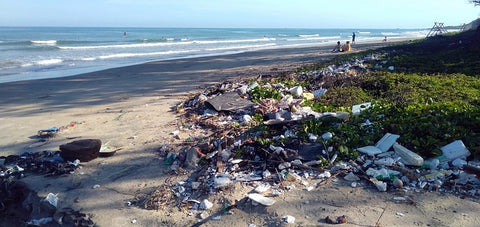We use plastics in our eco packaging. But hear us out – when it comes to pet food, it’s the best material for both your pupper and the planet. That’s because finding the right packaging is a delicate balance between pet nutrition and recyclability.
You use plastic?!
Yes, we use polyethylene (PE) for our dry food bags and polypropylene (PP5) with a cardboard sleeve for our wet food trays. Why so many Ps? Because we take great pride in the health benefits of our food and plastic guarantees your furry friend can enjoy the product’s quality as intended. What’s more, those plastics can be easily and almost infinitely recycled, creating new packaging without the need for virgin materials (something paper, textiles and steel can’t claim). What’s more, lots of local authorities in the UK will collect those recyclable plastics with your curbside collection, and companies like Veolia, SUEZ, and Biffa are increasingly turning this ‘waste’ back into a resource. All you need to do is keep our recyclable packaging out of the black rubbish bag. Instead, think of it as a healthy snack for the recycling bin.
But wait, isn’t plastic the enemy?
Actually, no. Plastic’s greatest asset is also what makes it a potential threat to our ecosystems – it’s durability. You might’ve heard about the 8 million tons of plastic that end up in oceans every year. It can wind up back in our water and food as microplastics and destroy natural habitats and trap wildlife, injuring our animal friends. But it doesn’t have to. You see, it’s not the plastic itself that’s the problem, it’s how we handle it.

For one, humans produce, use, and discard A LOT of single use plastic. The main culprits are polyvinyl chloride (PVC) and polystyrene (PS). Films, food trays, and disposable cutlery are made from these. They’re not currently recyclable, and putting them into the recycling bin spoils the whole load so everything ends up at incinerators, or worse, in landfills. Both release gases that’ll put your pup’s worst toot to shame and cause some serious environmental damage. Luckily, our packaging doesn’t have to face the same fate, as long as it goes in the right bin with other friendly recyclable plastics.
How can we make plastic a friend, not a foe?
First, we need to design out waste. This means only using plastics if there’s no bio-degradable or natural alternative, and making sure the ones we do use are recyclable. But it can also mean using plastics instead of materials that would have a more detrimental environmental impact. Imagine how much more fuel it would take to transport pet food in steel boxes, or how much food would be thrown away if plastic didn’t extend its shelf-life.
Second, we all need to do our bit. Policy-makers, manufacturers, and waste management companies in the UK are making great strides, but it begins with one very important detail: you putting plastic items in the right bin.
And lastly, follow the science, not the hype. Use your nose to sniff out the truth about the impact of the packaging used by your favorite brands. And check resources like The Ellen MacArthur Foundation, The Ocean Cleanup, eXXpedition or A Plastic Ocean for trustworthy information.
We’re transparent about our packaging, but we also encourage people to speak up – if we got something wrong or there’s a better alternative, we want to hear about it. We can’t claim to have found the holy grail yet, but we’re working hard to reduce our environmental impact while offering the best nutrition for your floofer’s gut.
How to dispose of our eco packaging:



